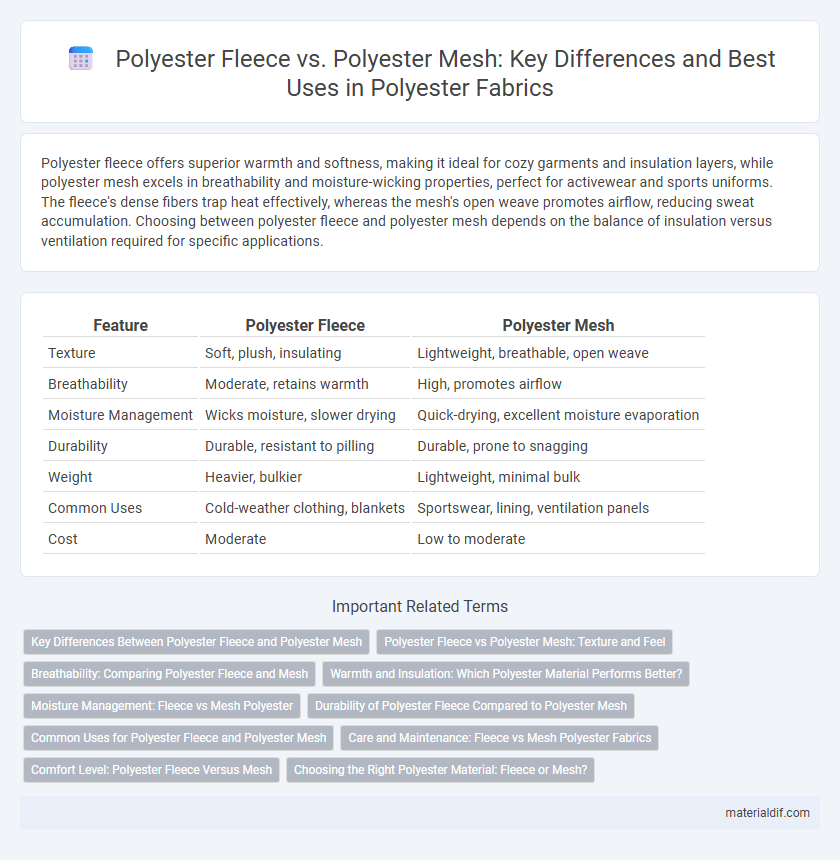Polyester fleece offers superior warmth and softness, making it ideal for cozy garments and insulation layers, while polyester mesh excels in breathability and moisture-wicking properties, perfect for activewear and sports uniforms. The fleece's dense fibers trap heat effectively, whereas the mesh's open weave promotes airflow, reducing sweat accumulation. Choosing between polyester fleece and polyester mesh depends on the balance of insulation versus ventilation required for specific applications.
Table of Comparison
| Feature | Polyester Fleece | Polyester Mesh |
|---|---|---|
| Texture | Soft, plush, insulating | Lightweight, breathable, open weave |
| Breathability | Moderate, retains warmth | High, promotes airflow |
| Moisture Management | Wicks moisture, slower drying | Quick-drying, excellent moisture evaporation |
| Durability | Durable, resistant to pilling | Durable, prone to snagging |
| Weight | Heavier, bulkier | Lightweight, minimal bulk |
| Common Uses | Cold-weather clothing, blankets | Sportswear, lining, ventilation panels |
| Cost | Moderate | Low to moderate |
Key Differences Between Polyester Fleece and Polyester Mesh
Polyester fleece features a soft, insulating texture ideal for warmth and comfort, making it perfect for cold-weather apparel and blankets. Polyester mesh offers a lightweight, breathable structure with open knit patterns that enhance ventilation, commonly used in sportswear and activewear. The key differences lie in fleece's heat retention properties versus mesh's moisture-wicking and airflow capabilities.
Polyester Fleece vs Polyester Mesh: Texture and Feel
Polyester fleece features a soft, plush texture that provides warmth and insulation, making it ideal for cold weather apparel. In contrast, polyester mesh is lightweight with a breathable, open-weave structure that enhances ventilation and moisture-wicking properties. The tactile difference is notable, as fleece offers a cozy, cushioned feel while mesh delivers a smooth, airy sensation.
Breathability: Comparing Polyester Fleece and Mesh
Polyester mesh offers superior breathability compared to polyester fleece due to its open weave structure that allows increased air circulation and moisture evaporation. Polyester fleece, made from tightly knit fibers, provides warmth and insulation but tends to trap heat and moisture, reducing ventilation. For high-performance athletic wear or hot climates, polyester mesh is preferred for its enhanced airflow and cooling properties.
Warmth and Insulation: Which Polyester Material Performs Better?
Polyester fleece offers superior warmth and insulation compared to polyester mesh due to its dense, brushed fibers that trap heat effectively. Polyester mesh, characterized by its open weave, prioritizes breathability and moisture-wicking but provides minimal insulation, making it less suitable for cold conditions. For applications requiring maximum thermal retention, polyester fleece is the optimal choice.
Moisture Management: Fleece vs Mesh Polyester
Polyester fleece offers superior insulation while effectively wicking moisture away from the skin, keeping the wearer warm and dry during low to moderate activities. Polyester mesh, designed with open, breathable patterns, excels in rapid moisture evaporation and airflow, making it ideal for high-intensity workouts and hot environments. The choice between polyester fleece and mesh significantly impacts moisture management, depending on activity level and temperature conditions.
Durability of Polyester Fleece Compared to Polyester Mesh
Polyester fleece exhibits superior durability compared to polyester mesh due to its dense, brushed-knit construction that resists pilling and withstands frequent washing. The thick fibers in polyester fleece create a robust fabric ideal for insulation and heavy use, whereas polyester mesh, with its open, porous design, is more prone to snagging and tearing under stress. This makes polyester fleece the preferred choice for long-lasting, high-performance apparel and outerwear.
Common Uses for Polyester Fleece and Polyester Mesh
Polyester fleece is commonly used in activewear, outdoor apparel, and blankets due to its exceptional warmth, softness, and moisture-wicking properties. Polyester mesh finds extensive use in sports jerseys, athletic footwear, and backpacks because of its breathable structure and durability. Both materials serve distinct purposes in textile manufacturing, catering to thermal insulation needs and ventilation requirements respectively.
Care and Maintenance: Fleece vs Mesh Polyester Fabrics
Polyester fleece requires gentle care, including washing in cold water and avoiding high heat drying to maintain softness and prevent pilling. Polyester mesh, being more breathable and lightweight, benefits from gentle cycle washing and air drying to preserve its structure and avoid shrinkage. Both fabrics resist wrinkles, but fleece demands more delicate handling due to its thicker, plush texture compared to the durable, airy knit of polyester mesh.
Comfort Level: Polyester Fleece Versus Mesh
Polyester fleece offers superior warmth and softness, making it ideal for cold weather and cozy apparel. Polyester mesh provides excellent breathability and moisture-wicking properties, enhancing comfort during physical activities or hot conditions. Choosing between fleece and mesh depends on whether insulation or ventilation is the primary comfort requirement.
Choosing the Right Polyester Material: Fleece or Mesh?
Polyester fleece offers superior warmth and softness, making it ideal for cold-weather apparel and cozy activewear, while polyester mesh provides excellent breathability and moisture-wicking properties, suited for athletic wear and ventilation-focused garments. When choosing between polyester fleece and mesh, consider the intended use environment: fleece excels in insulation and comfort, whereas mesh prioritizes airflow and quick drying. Selecting the right polyester material depends on functional needs such as thermal regulation and breathability to maximize performance and comfort.
Polyester Fleece vs Polyester Mesh Infographic

 materialdif.com
materialdif.com